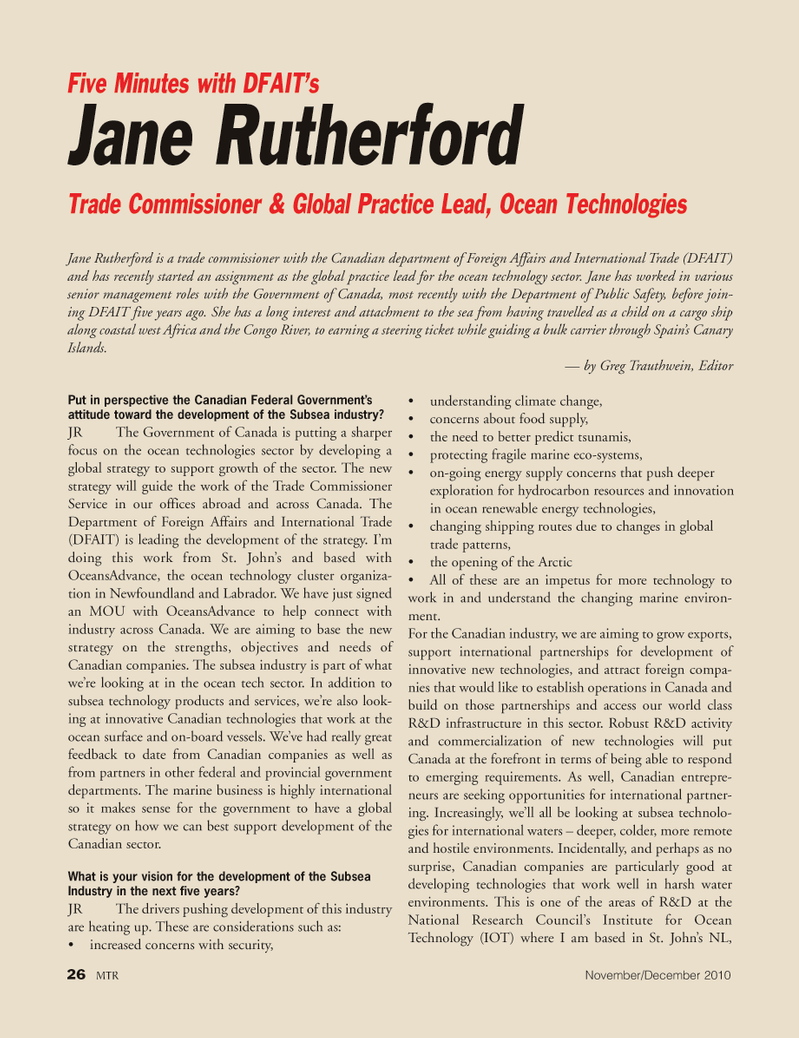
Page 26: of Marine Technology Magazine (November 2010)
Fresh Water Monitoring and Sensors(lakes, rivers, reservoirs)
Read this page in Pdf, Flash or Html5 edition of November 2010 Marine Technology Magazine
Put in perspective the Canadian Federal Government’s attitude toward the development of the Subsea industry?
JR The Government of Canada is putting a sharper focus on the ocean technologies sector by developing a global strategy to support growth of the sector. The new strategy will guide the work of the Trade Commissioner
Service in our offices abroad and across Canada. The
Department of Foreign Affairs and International Trade (DFAIT) is leading the development of the strategy. I’m doing this work from St. John’s and based with
OceansAdvance, the ocean technology cluster organiza- tion in Newfoundland and Labrador. We have just signed an MOU with OceansAdvance to help connect with industry across Canada. We are aiming to base the new strategy on the strengths, objectives and needs of
Canadian companies. The subsea industry is part of what we’re looking at in the ocean tech sector. In addition to subsea technology products and services, we’re also look- ing at innovative Canadian technologies that work at the ocean surface and on-board vessels. We’ve had really great feedback to date from Canadian companies as well as from partners in other federal and provincial government departments. The marine business is highly international so it makes sense for the government to have a global strategy on how we can best support development of the
Canadian sector.
What is your vision for the development of the Subsea
Industry in the next five years?
JR The drivers pushing development of this industry are heating up. These are considerations such as: • increased concerns with security, • understanding climate change, • concerns about food supply, • the need to better predict tsunamis, • protecting fragile marine eco-systems, • on-going energy supply concerns that push deeper exploration for hydrocarbon resources and innovation in ocean renewable energy technologies, • changing shipping routes due to changes in global trade patterns, • the opening of the Arctic • All of these are an impetus for more technology to work in and understand the changing marine environ- ment.
For the Canadian industry, we are aiming to grow exports, support international partnerships for development of innovative new technologies, and attract foreign compa- nies that would like to establish operations in Canada and build on those partnerships and access our world class
R&D infrastructure in this sector. Robust R&D activity and commercialization of new technologies will put
Canada at the forefront in terms of being able to respond to emerging requirements. As well, Canadian entrepre- neurs are seeking opportunities for international partner- ing. Increasingly, we’ll all be looking at subsea technolo- gies for international waters – deeper, colder, more remote and hostile environments. Incidentally, and perhaps as no surprise, Canadian companies are particularly good at developing technologies that work well in harsh water environments. This is one of the areas of R&D at the
National Research Council’s Institute for Ocean
Technology (IOT) where I am based in St. John’s NL, 26 MTR November/December 2010
Five Minutes with DFAIT’s
Jane Rutherford
Trade Commissioner & Global Practice Lead, Ocean Technologies
Jane Rutherford is a trade commissioner with the Canadian department of Foreign Affairs and International Trade (DFAIT) and has recently started an assignment as the global practice lead for the ocean technology sector. Jane has worked in various senior management roles with the Government of Canada, most recently with the Department of Public Safety, before join- ing DFAIT five years ago. She has a long interest and attachment to the sea from having travelled as a child on a cargo ship along coastal west Africa and the Congo River, to earning a steering ticket while guiding a bulk carrier through Spain’s Canary
Islands. — by Greg Trauthwein, Editor

 25
25

 27
27
